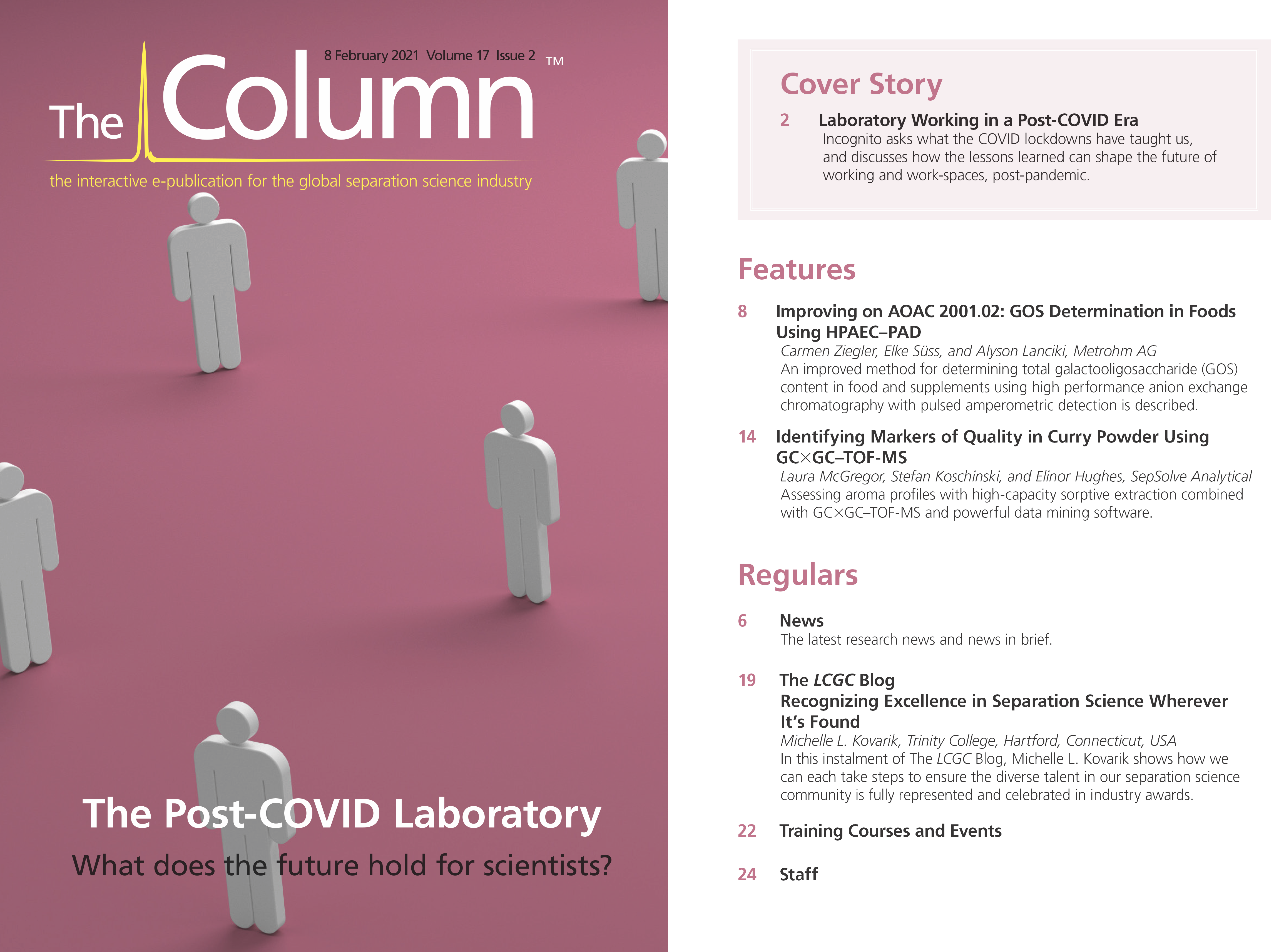Recognizing Excellence in Separation Science Wherever It’s Found
In this installment of The LCGC Blog, Michelle L. Kovarik shows how we can each take steps to ensure the diverse talent in our separation science community is fully represented and celebrated in industry awards.
The separation science community is full of talented, productive, and innovative researchers of all genders, from diverse racial and ethnic backgrounds, working around the globe in academia and industry. Our awards should reflect this. It is one thing to say this. It is another thing to do it. But there are steps we can each take to ensure that our awards showcase the full range of separation science talent.
Recently I was finalizing a nomination for a separation science award, and I found myself frustrated to be spending so much time pulling together statements, letters, and publication lists for a deserving nominee who frankly should have been recognized years ago. I don’t mean to suggest that recent winners were not fully deserving—because they clearly were. But it’s also clear to me that the separations community tends to recognize researchers from the same small pool of scientists and their trainees, and does a poor job reflecting the diversity of talent in our field in our awardees. (I’m not the only person to have noticed this issue. See, for example, the November 2019 Analytical Chemistry editorial by Jonathan Sweedler [1] and the recent anonymous open letter from the Selection Committee for the ACS Award in Analytical Chemistry [2].)
The separation science community is full of talented, productive, and innovative researchers of all genders, from diverse racial and ethnic backgrounds, working around the globe in academia and industry. Our awards should reflect this. It is one thing to say this. It is another thing to do it. But there are steps we can each take to ensure that our awards showcase the full range of separation science talent.
Nominate Worthy Scientists
No one wins an award they weren’t nominated for. If you know a worthy scientist, nominate them! Don’t assume that someone has already done it. A 2016 research study (3) showed that, in hiring situations, a finalist pool with only one female candidate has approximately 0% chance of hiring a woman. Similar results were seen for the probability of hiring a black candidate. It seems likely that similar effects occur in award selection, meaning it’s important to have truly inclusive finalist lists, not just token representation. And a robust pool of nominees is more likely to result in recognition of excellence.
Use Best Practices When Selecting Awardees
If you are serving on an award selection committee, review best practices and encourage the selection committee chair to ask all award judges to do the same. If you chair such a committee, insist on this and be sure to appoint a diverse selection committee. You can make a big impact with simple, evidence-based steps (4) like defining selection criteria before reviewing any applications; having judges individually prepare a personal shortlist before sharing suggestions; constructing the finalist list by adding nominees rather than eliminating them; and not rushing through the selection process.
Mentor the Next Generation of Separation Scientists
Formal recognition in the form of awards usually grows out of less formal acknowledgment and encouragement of a person’s accomplishments. There’s something heartwarming about meeting a young scientist and thinking, “You remind me of myself at your age”. In part, we may be recognizing enthusiasm or curiosity, but research on homophily (5) shows that we are also more responsive and connected to people who are like us in more identifiable ways, such as race and gender. We should remind ourselves regularly to reach out to students and trainees who aren’t like us, so that we don’t just reproduce our professional community as it is now. Instead, we should draw in new talent from all backgrounds.
Diverse teams have been found to be more creative in controlled laboratory studies (6), in business (7), and in scientific research (8). Continued innovation in separations depends on a diverse workforce, and we should all be working to build that future. So speak well of your accomplished colleagues, recruit diverse speakers for symposia and panels, and reach out to students and trainees about opportunities for them to advance. This ensures a diverse pool of excellent candidates for awards for years to come.
Perhaps you already know all these things and are doing them. I hope this is the case. For me, writing this post was a useful opportunity to remind myself that, although preparing a nomination may be time consuming and a little tedious, it is a worthwhile task to keep moving my professional community toward a future where we recognize excellence wherever it’s found. I hope it will encourage you in the same way.
References
1. J.V. Sweedler, Anal. Chem. 91(23), 14783 (2019).
2. ACS Division of Analytical Chemistry, “A Special Message from the Division,” September 1, 2020. https://acsanalytical.org/2020/09/01/a-special- message-from-the-division, accessed Jan. 28, 2021.
3. S.K. Johnson, D.R. Hekman, and E.T. Chan, Harv. Bus. Rev., April 26, 2016.
4. Association for Women in Science, “Avoiding Implicit Bias: Best Practices for Award Selection Committees”, May 2011. https://honors.agu. org/files/2014/11/AWARDS-SUGGESTED-BEST- PRACTICES-MAY2011.pdf, accessed Jan. 28, 2021.
5. M. McPherson, L. Smith-Lovin, and J.M. Cook, Annu. Rev. Sociol. 27, 415–444 (2001).
6. P.L. McLeod, S.A. Lobel, and T.H. Cox Jr., Small Group Res. 27(2), 248–264 (1996).
7. Vivian Hunt, Sara Prince, Sundiatu Dixon-Fyle, and Lareina Yee, “Delivering through Diversity,” McKinsey & Company, Jan 2018. https://www.mckinsey.com/~/media/McKinsey/Business%20Functions/Organization/Our%20Insights/ Delivering%20through%20diversity/Delivering-through-diversity_full-report.ashx, accessed Jan. 28, 2021.
8. R.B. Freeman and W. Huang, National Bureau of Economics Research, 19905 (Feb 2014). DOI: 10.3386/w19905, accessed Jan. 28, 2021.
This blog is a collaboration between LCGC and the American Chemical Society Analytical Division Subdivision on Chromatography and Separations Chemistry.
Michelle L. Kovarik is an Associate Professor of Chemistry at Trinity College in Hartford, Connecticut, USA. She received her PhD in Analytical Chemistry from Indiana University (Bloomington, Indiana, USA) in 2009. She was a postdoctoral scholar from 2010 to 2013 at the University of North Carolina, Chapel Hill, North Carolina, USA. Her current interests include microchip electrophoresis with laser‐induced fluorescence detection; microfluidic single‐cell analysis; and kinase and peptide assays in Dictyostelium discoideum. She is the recipient of numerous honors and awards, including the Arthur H. Hughes Award for Achievement in Teaching, Trinity College (2019). She is a member of the American Association for the Advancement of Science (AAAS); the American Chemical Society (ACS); and the curriculum development team and workshop facilitator for the Analytical Sciences Digital Library Active Learning group (2014–present). Since 2004, she has published 25 peer‐reviewed manuscripts and given 32 presentations at local, regional, national, and international meetings.
Email: michelle.kovarik@trincoll.edu
Website: www.chromatographyonline.com

New Method Explored for the Detection of CECs in Crops Irrigated with Contaminated Water
April 30th 2025This new study presents a validated QuEChERS–LC-MS/MS method for detecting eight persistent, mobile, and toxic substances in escarole, tomatoes, and tomato leaves irrigated with contaminated water.
Accelerating Monoclonal Antibody Quality Control: The Role of LC–MS in Upstream Bioprocessing
This study highlights the promising potential of LC–MS as a powerful tool for mAb quality control within the context of upstream processing.
University of Tasmania Researchers Explore Haloacetic Acid Determiniation in Water with capLC–MS
April 29th 2025Haloacetic acid detection has become important when analyzing drinking and swimming pool water. University of Tasmania researchers have begun applying capillary liquid chromatography as a means of detecting these substances.

.png&w=3840&q=75)

.png&w=3840&q=75)



.png&w=3840&q=75)



.png&w=3840&q=75)










